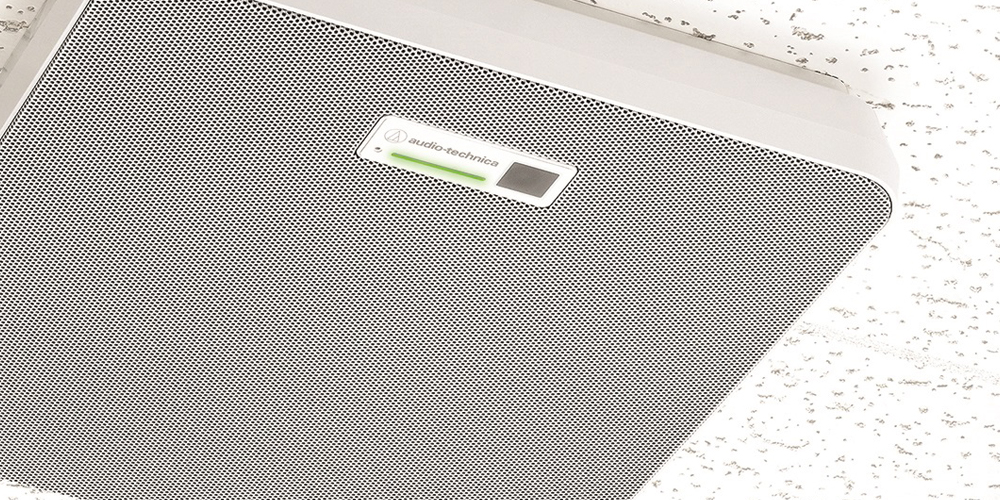Beamforming microphones have become much more common over the last several years and, often, are among the first choices when considering microphones for meeting spaces. When considering a beamforming array, there are several considerations to be taken into account before making a decision.
Here, Mark Donovan, CTS-D, CTS-I, applications engineering manager, professional markets, Audio-Technica, offers a deep dive on the unique value proposition that the ATND1061 beamforming ceiling array microphone offers.
Commercial Integrator: How can beamforming microphones like the ATND1061 improve meeting sound quality?
Mark Donovan: In any microphone application, whether it’s live sound, studio, broadcast, or meeting spaces, the ability to accurately capture sound depends entirely on where the microphone is pointed and what the gain level settings are of those microphones.
Within zones that are assigned when setting up the ATND1061, the microphone is able to calculate the talker location and maintain the center of the beam on that talker. Your microphone beams will remain confined to zones that you define, preventing the beam from moving towards an area you wish to avoid. The microphone is also able to use that location information to calculate distance and will vary the gain as a talker gets closer to or further from the microphone. This provides a smooth volume level as the talker moves within the defined zone. When there is no talker within the zone, the beam will go into an inactive state that reduces the level by a user defined amount.
The zones can be assigned to up to six different beams allowing dedicated coverage of up to six simultaneous talkers. The first zone type is for the Coverage Beam. This beam is used for general coverage of an area. The remaining five beams are Priority Beams and they are used to define areas that are more important, such as the seat for the presiding officer of a meeting or an instructor in a classroom. By combining these beams, you can ensure important individuals are picked up in Priority Beams while others can still be picked up by the Coverage Beam.
Commercial Integrator: How difficult is the ATND1061 to set up and operate?
Mark Donovan: Out of the box, the ATND1061 comes with a single zone for the Coverage Beam drawn over the entire 5-meter coverage radius (10 meters or 32.8 feet in diameter). This zone is automatically routed to Dante output number 1 and can be routed to the DSP of your choice for processing simply using Dante Controller.
If you wish to take advantage of the Priority Beams within the microphone, you will simply need to connect to the microphone through Audio-Technica’s Digital Microphone Manager software and define the size and location of the pickup zones. Each of the six beams can be routed to individual Dante outputs for external processing or you can choose to use the internal DSP of the ATND1061.
The internal DSP provides many necessary functions within a single package, including a gain-sharing automatic mixer, Automatic Gain Control (AGC), Noise Cancellation (NC), and Acoustic Echo Cancellation (AEC). The settings for these DSP blocks are also accessed through the Digital Microphone Manager software via a simple and intuitive GUI. Using the internal DSP can eliminate the need for external DSPs in many applications and does not require extensive programming skills.
Commercial Integrator: What are my options if I don’t wish to use or don’t have any other Dante devices in the system?
Mark Donovan: Along with the Dante input and output options, the ATND1061 also has analog I/O. The analog input is used to feed a reference signal to the Acoustic Echo Cancellation (AEC) circuitry. The analog output comes from the automatic mixer outputs, providing the sum of all beams on a single balanced audio line. These signals can be connected to any device with analog I/O to bridge into your computer, such as a hardware codec or a simple analog USB interface.
A network connection with Power over Ethernet (PoE) will still be required to power the microphone and to connect the Digital Microphone Manager software for configuration.
Commercial Integrator: How can the ATND1061 help mitigate noise?
Mark Donovan: As mentioned before, your sound quality depends entirely on where the microphone is pointed and what the gain level settings are of those microphones. This is also key to reducing the amount of noise that may enter the audio chain.
The Voice Activity Detection (VAD) algorithms built into the beamforming section of the ATND1061 do a great job of distinguishing noise from voice, but it is possible that the VAD can get fooled, depending on your settings. You can adjust the sensitivity of the VAD algorithm, but these settings are a tradeoff between reaction speed and false trigger reduction.
Setting up the beam zones correctly is the critical first step in mitigating noise. When setting up a room, make sure you draw your zones so that the beam won’t be drawn towards random noises that could fool the VAD algorithms. You can accomplish this by not drawing any zones over potential noise source or by drawing an Exclusion Zone over a potential noise source. Exclusion Zones tell the beamforming algorithms not to move towards any sound within them regardless of the VAD algorithm results.
For steady state noises such as air handlers and projector fans, the ATND1061 has a Noise Cancellation (NC) processing block built into the mixed output. This processing can provide up to 20dB of noise attenuation and is very effective in reducing steady state background noise.
For extremely challenging applications, you are not confined to using the tools built into the microphone. You have the ability to route the raw beam output to external DSPs via Dante. These DSP’s can provide more advanced processing such as gated priority mixing and advanced noise reduction.
Commercial Integrator: How can the ATND1061DAN be integrated with cameras?
Mark Donovan: Audio-Technica has considered the question from the very beginning. Most beamforming microphones provide their beam location data and signal levels within those beams to external hardware and software so that that information can be used to determine if a camera preset should be recalled. These external software or hardware devices then send the appropriate commands to the cameras in a language the cameras can understand.
The ATND1061 has this same capability but was designed with 15 camera zones that exist separately from the audio zones. This means that you can provide location data on 15 different zones without affecting your carefully tuned audio. This data can then be captured by the same third-party hardware and software packages to control cameras.
Recently, Audio-Technica released a new firmware update for the ATND1061 that skips that intermediate step and allows to take the data from those 15 camera zones and communicate directly with many Pan/Tilt/Zoom cameras available on the market today. This is done using a protocol from the PTZ camera industry known as VISCA over IP. Using the Audio-Technica Digital Microphone Manager software, you simply identify the camera IP address, then assign your camera zones to a specific preset recall on the camera. This is a great way to elevate the experience in a simple small to medium meeting space without breaking the bank.
For larger and more complex spaces where multiple camera angles and video might be required, integration with third party hardware and software is still an excellent option.
To read more Commercial Integrator coverage of audio technologies, check out our Line Array Speaker hub page.











